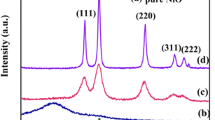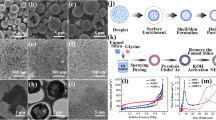Abstract
Surface-nitrogen enriched carbon spheres with core–shell structure were prepared by a facile and general strategy with dopamine and melamine as the precursors. This strategy includes three steps: the polymerization of dopamine to form polydopamine (PDA) spheres, the soaking of spheres in melamine (MA) and the pyrolysis of PDA spheres/MA. The resulting carbon spheres as electrode materials for supercapacitors display better performances than common N-doped carbon spheres (NCS) with a high specific capacitance (203 F/g at 0.5 A/g), acceptable rate capability (66% retention at 5 A/g) and good long-term stability (94.6% retention after 5000 cycles at 2 A/g). This formation of polymer spheres-soaking in inflating agent-pyrolysis strategy makes it easy to produce surface-nitrogen-rich and hierarchically porous carbon spheres on a large scale with different sources. These carbon spheres hold great potential applications in energy storage and conversion devices such as supercapacitors and fuel cells due to their unique structure and hierarchical composition.






Similar content being viewed by others
References
Dai L, Xue Y, Qu L, Choi H-J, Baek J-B (2015) Metal-free catalysts for oxygen reduction reaction. Chem Rev 115:4823–4892
Asefa T (2016) Metal-free and noble metal-free heteroatom-doped nanostructured carbons as prospective sustainable electrocatalysts. Acc Chem Res 49:1873–1883
Zhu CZ, Li H, Fu SF, Du D, Lin YH (2016) Highly efficient nonprecious metal catalysts towards oxygen reduction reaction based on three-dimensional porous carbon nanostructures. Chem Soc Rev 45:517–531
Hu FY, Wang JY, Hu S, Li LF, Wang G, Qiu JS, Jian XG (2016) Inherent N, O-containing carbon frameworks as electrode materials for high-performance supercapacitors. Nanoscale 8:16323–16331
Zhu S, Li JJ, Ma LY, Guo LC, Li QY, He CN, Liu EZ, He F, She CS, Zhao NQ (2016) Three-dimensional network of N-doped carbon ultrathin nanosheets with closely packed mesopores: controllable synthesis and application in electrochemical energy storage. ACS Appl Mater Interfaces 8:11720–11728
Wei XJ, Wan SG, Gao SY (2016) Self-assembly-template engineering nitrogen-doped carbon aerogels for high-rate supercapacitors. Nano Energy 28:206–215
Hu LT, Hou JX, Ma Y, Li HQ, Zhai TY (2016) Multi-heteroatom self-doped porous carbon derived from swim bladders for large capacitance supercapacitors. J Mater Chem A 4:15006–15014
Tian HD, Wang L, Sofer Z, Pumera M, Bonanni A (2016) Doped graphene for DNA analysis: the electrochemical signal is strongly influenced by the kind of dopant and the nucleobase structure. Sci Rep 6:33046–33050
Liu YX, Ma YL, ** Y, Chen GQ, Zhang X (2015) Microwave-assisted solvothermal synthesis of sulfur-doped graphene for electrochemical sensing. J Electroanal Chem 739:172–177
Tang J, Liu J, Li CL, Li YQ, Tade MO, Dai S, Yamauchi Y (2015) Synthesis of nitrogen-doped mesoporous carbon spheres with extra-large pores through assembly of diblock copolymer micelles. Angew Chem Int Ed 54:588–593
Chen KY, Huang XB, Wan CY, Liu H (2015) Efficient oxygen reduction catalysts formed of cobalt phosphide nanoparticle decorated heteroatom-doped mesoporous carbon nanotubes. Chem Commun 51:7891–7894
Thirumal V, Pandurangan A, Jayavel R, Ilangovan R (2016) Preparation and characterization of carbon nanotubes for supercapacitor applications. Synth. Metals 220:524–532
Balaji SS, Elavarasan A, Sathish M (2016) High performance supercapacitor using N-doped graphene prepared via supercritical fluid processing with an oxime nitrogen source. Electrochim Acta 200:37–45
Xu J, Tan Z, Zeng W, Chen G, Wu S, Zhao Y, Ni K, Tao Z, Ikram M, Ji H, Zhu Y (2016) A hierarchical carbon derived from sponge-templated activation of graphene oxide for high-performance supercapacitor electrodes. Adv Mater 28:5222–5228
Liu J, Wickramaratne NP, Qiao SZ, Jaroniec M (2015) Molecular-based design and emerging applications of nanoporous carbon spheres. Nat Mater 14:763–774
Wickramaratne NP, Xu J, Wang M, Zhu L, Dai L, Jaronie M (2014) Nitrogen enriched porous carbon spheres: attractive materials for supercapacitor electrodes and CO2 adsorption. Chem Mater 26:2820–2828
Tesfu-Zeru T, Sakthivel M, Drillet JF (2017) Investigation of mesoporous carbon hollow spheres as catalyst support in DMFC cathode. Appl Catal B Environ 204:173–184
Zhou TS, Zhou Y, Ma RG, Zhou ZZ, Liu GH, Liu Q, Zhu YF, Wang JC (2017) Nitrogen-doped hollow mesoporous carbon spheres as a highly active and stable metal-free electrocatalyst for oxygen reduction. Carbon 114:177–186
Ai K, Liu Y, Ruan C, Lu L, Lu G (2013) Sp2 C-dominant N-doped carbon sub-micrometer spheres with a tunable size: a versatile platform for highly efficient oxygen-reduction catalysts. Adv Mater 25:998–1003
He Z, Han XJ, Du YC, Song B, Xu P, Zhang B (2016) Bifunctional nitrogen-doped microporous carbon microspheres derived from poly(o-methylaniline) for oxygen reduction and supercapacitors. ACS Appl Mater Interfaces 8:3601–3608
Liu C, Wang J, Li J (2016) Synthesis of N-doped hollow-structured mesoporous carbon nanospheres for high-performance supercapacitors. ACS Appl Mater Interfaces 8:7194–7204
Zhang L, Li H, Shi Y, Fan C, Wu X, Wang H, Sun H, Zhang J (2016) A novel layered sedimentary rocks structure of the oxygen- enriched carbon for ultrahigh-rate-performance supercapacitors. ACS Appl Mater Interfaces 8:4233–4241
Jiang X, Wang Y, Li M (2014) Selecting water-alcohol mixed solvent for synthesis of polydopamine nano-spheres using solubility parameter. Sci Rep 4:6070–6074
Wang YL, Zhang XM, Li AN, Li MG (2015) Intumescent flame retardant–derived p, n co-doped porous carbon as an efficient electrocatalysts for the oxygen reduction reaction. Chem Commun 51:14801–14804
Xu T, Song J, Gordin ML, Sohn H, Yu Z, Chen S, Wang D (2013) Mesoporous carbon − carbon nanotube − sulfur composite microspheres for high-areal-capacity lithium − sulfur battery cathodes. ACS Appl Mater Interfaces 5:11355–11362
Sivadas DL, Vijayan S, Rajeev R, Ninan KN, Prabhakaran K (2016) Nitrogen-enriched microporous carbon derived from sucrose and urea with superior CO2 capture performance. Carbon 109:7–18
Sheng Z-H, Shao L, Chen J-J, Bao W-J, Wang F-B, **a X-H (2011) Catalyst-free synthesis of nitrogen-doped graphene via thermal annealing graphite oxide with melamine and its excellent electrocatalysis. ACS Nano 5:4350–4358
Xu J, Zhao Y, Shen C, Guan L (2013) Sulfur- and nitrogen-doped, ferrocene-derived mesoporous carbons with efficient electrochemical reduction of oxygen. ACS Appl Mater Interfaces 5:12594–12601
Lai L, Potts JR, Zhan D, Wang L, Poh CK, Tang C, Gong H, Shen Z, Lin J, Ruoff RS (2012) Exploration of the active center structure of nitrogen-doped graphene-based catalysts for oxygen reduction reaction. Energy Environ Sci 5:7936–7942
Li Z, Xu ZW, Wang HL, Ding J, Zahiri B, Holt CMB, Tan XH, Mitlin D (2014) Colossal pseudocapacitance in a high functionality–high surface area carbon anode doubles the energy of an asymmetric supercapacitor. Energy Environ Sci 7:1708–1718
Wu TX, Wang GZ, Zhang X, Chen C, Zhang YX, Zhao HJ (2015) Transforming chitosan into N-doped graphitic carbon electrocatalysts. Chem Commun 51:1334–1337
Lee KJ, Sa YJ, Jeong HY, Bielawski CW, Joo SH, Moon HR (2015) Simple coordination complex-derived three-dimensional mesoporous graphene as an efficient bifunctional oxygen electrocatalyst. Chem Commun 51:6773–6776
Cai T, **ng W, Liu Z, Zeng J, Xue Q, Qiao S, Yan Z (2015) Superhigh-rate capacitive performance of heteroatoms-doped double shell hollow carbon spheres. Carbon 86:235–244
Liu L, Xu S, Yu Q, Wang F, Zhu H, Zhang R, Liu X (2016) Nitrogen-doped hollow carbon spheres with a wrinkled surface: their one-pot carbonization synthesis and supercapacitor properties. Chem Commun 52:11693–11696
Yuan C, Liu X, Jia M, Luo Z, Yao J (2015) Facile preparation of N- and O-doped hollow carbon spheres derived from poly(o-phenylenediamine) for supercapacitors. J Mater Chem A 3:3409–3415
Acknowledgements
Dr. Y. L. Wang thanks the Anhui Provincial Natural Science Foundation (1408085QB27) for financial support. Dr. X. W. Liu is grateful for the financial support from the National Natural Science Foundation of China (21471007). Dong is grateful for the financial support from the AHNU Innovation Foundation (2016yks056). This work was also supported by Foundation for Innovation Team of Bioanalytical Chemistry.
Author information
Authors and Affiliations
Corresponding author
Rights and permissions
About this article
Cite this article
Wang, Y., Dong, S., Wu, X. et al. Core–shell N-doped carbon spheres for high-performance supercapacitors. J Mater Sci 52, 9673–9682 (2017). https://doi.org/10.1007/s10853-017-1117-3
Received:
Accepted:
Published:
Issue Date:
DOI: https://doi.org/10.1007/s10853-017-1117-3




